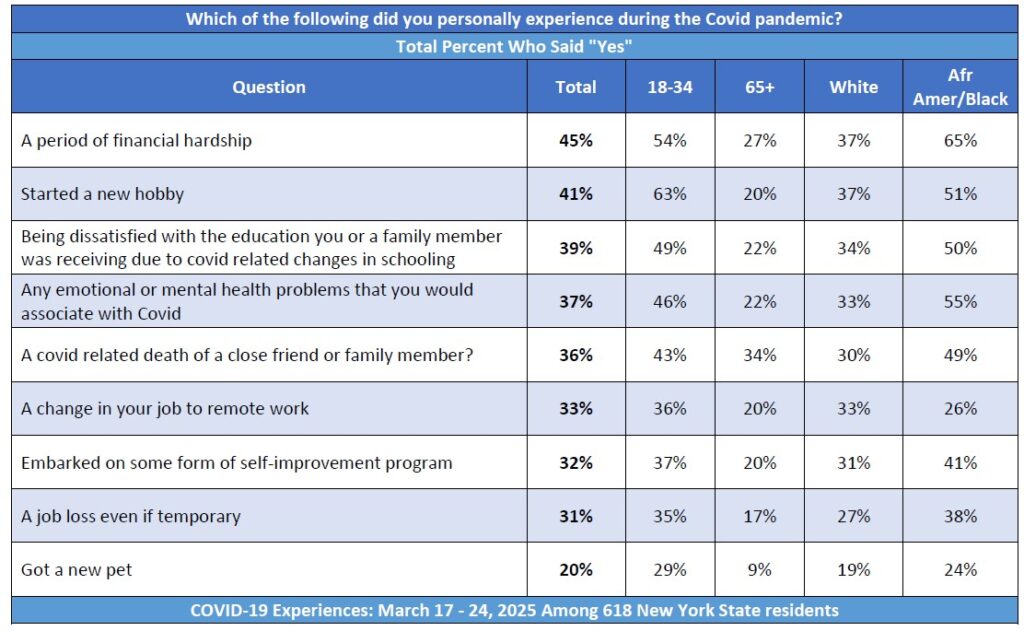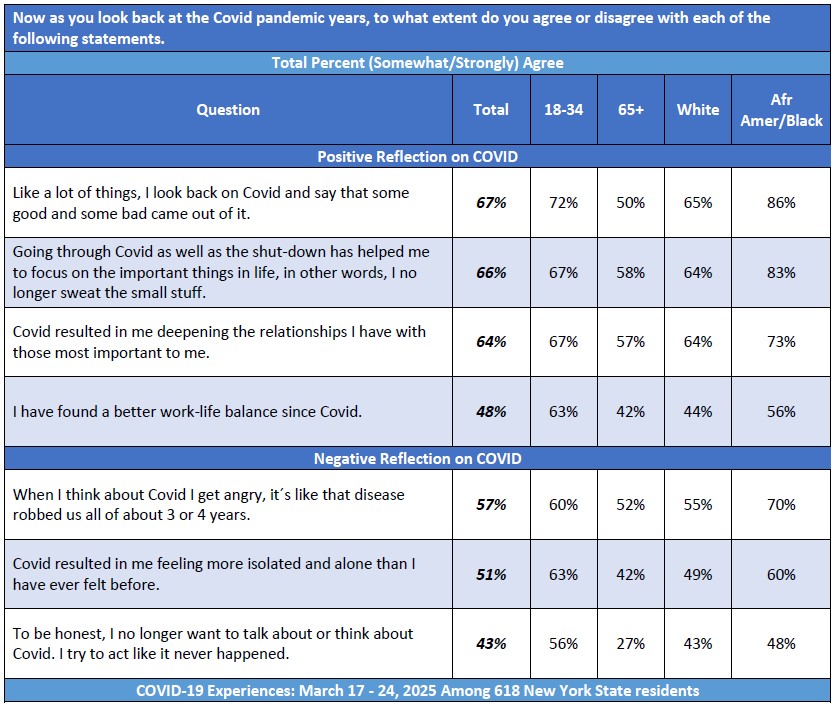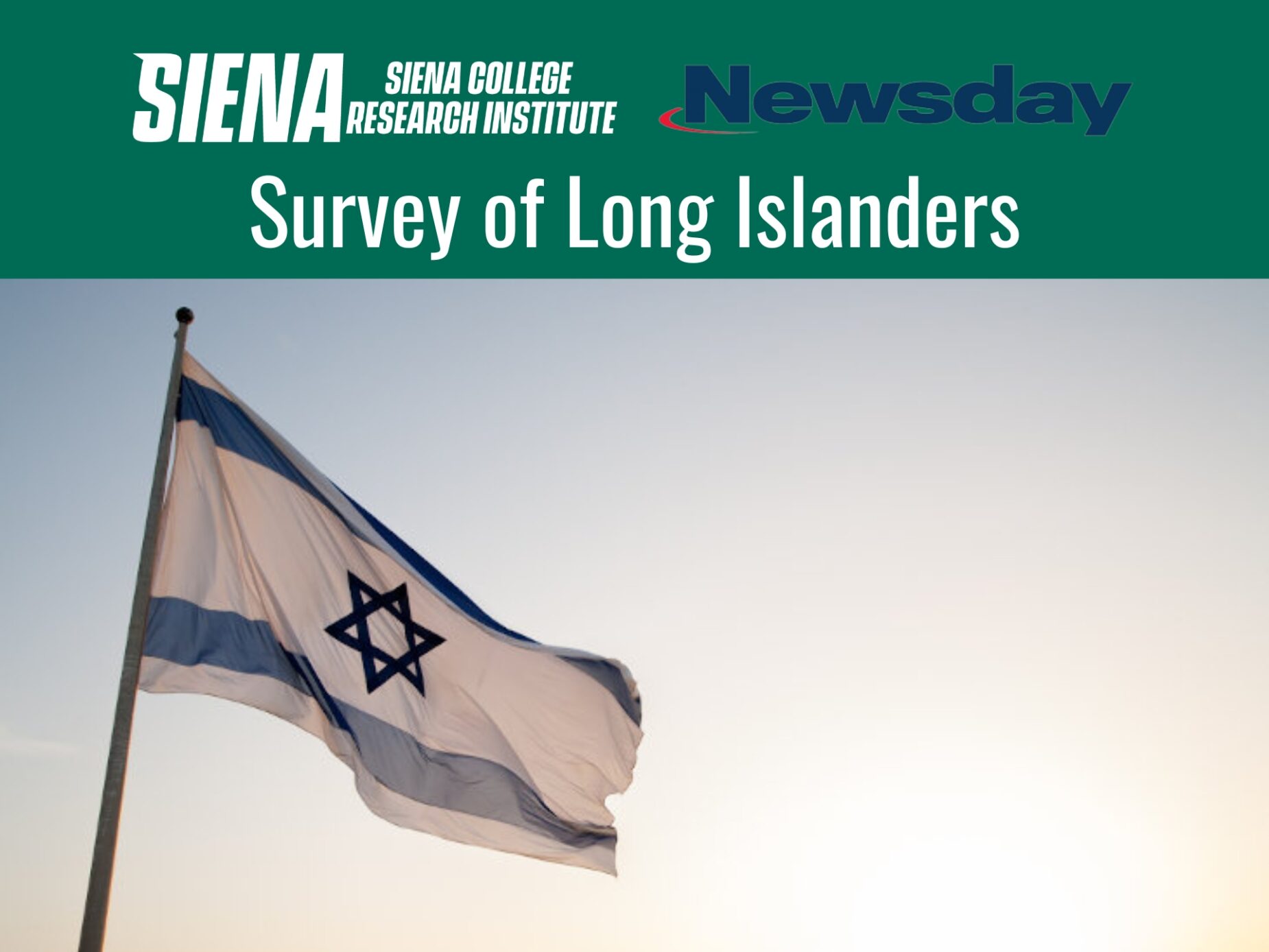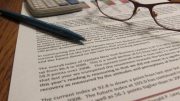- 2/3rds Say Pandemic Helped Them Focus on Family, Friends & Important Aspects of Life But 57% Angry About Being Robbed of 3 or 4 Years and 51% More Isolated than Ever
- Looking Back, Scientific Community & Local Health Officials Praised for Response, Federal Government Gets Failing Grade, New York State Breakeven; By 50-45%, U.S. NOT Prepared to Face Another Pandemic
Loudonville, NY – Five years after the start of the COVID-19 pandemic and lockdown, 67% of New Yorkers say they or a family member had the virus while 37% suffered through the disease more than once. Nearly half, 45% experienced a period of financial hardship during the pandemic, 31% had a job loss even if temporary, 33% changed to remote work and 36% had a close friend or family member die due to Covid according to a new survey released today from the Siena College Research Institute (SCRI).
Looking back, 66% agree that the shut-down helped them to focus on the important things in life, in other words, they say they ‘no longer sweat the small stuff’and 64% agree that Covid resulted in them deepening the relationships they have with those most important to them. But, 57% say that when they think about the pandemic they get angry as it’s like the disease robbed us all of about 3 or 4 years. A small majority, 51%, say that Covid resulted in them feeling more isolated and alone than they have ever felt before and 37% of all New Yorkers, 46% of young residents, say that they as a result of the pandemic had emotional or mental health problems.
“Almost half of New Yorkers, 43%, say that to be honest, they no longer want to talk about or think about Covid and that they try to act like it never happened,” said Don Levy, SCRI’s Director. “But it did happen. Two-thirds suffered through the disease once, over a third more than once and nearly half of us experienced financial pain as well. About a third lost a loved one, a job and a third had their work life shift to remote.”
“Two-thirds try to put a silver lining on the pandemic and insist that some good as well as bad came out of it. Many say they deepened their relationships, about half found a better work-life balance but 57% get angry when reflecting on Covid’s impacts and half, including 63% of young people, say the pandemic resulted in them feeling more alone than ever,” Levy said.
By 63-33% New Yorkers say the federal government’s response to the pandemic was no better than only fair or poor rather than excellent or good. New York State gets a breakeven assessment as 48% say the state government’s response was excellent or good while 49% rate the response as only fair or poor. By 59-38% New Yorkers rate the response of local health officials as excellent/good rather than only fair/poor and residents give the scientific community a positive assessment, 57-38%.
By 50-45% New Yorkers say that the country is not very or not at all prepared rather than being somewhat or very prepared should we face another pandemic as widespread and unanticipated as the Covid pandemic was.
“Thirty-nine percent of all residents, over half of those with children, remember being dissatisfied with the education children received due to the Covid related changes in schooling,” Levy said. “Residents now are split, 46-42% on whether or not public schools in their area ended up appropriately responding to the pandemic.”
“On the – ‘what did we do with all that time at home front’ – 41% of us started a new hobby, a third, 32%, embarked on some form of self-improvement program and 20% of us got a new pet during the pandemic,” Levy said.
###
This Siena College Poll was conducted March 17 – 24, 2025, among 618 New York State Residents. Of the 618 respondents, 281 were contacted through a dual frame (landline and cell phone) mode (33 completed via text to web) and 337 respondents were drawn from a proprietary online panel (Lucid). Telephone calls were conducted in English and respondent sampling was initiated by asking for the youngest person in the household. Telephone sampling was conducted via a stratified dual frame probability sample of landline and cell phone telephone numbers weighted to reflect known population patterns. The landline telephone sample was obtained from ASDE and the cell phone sample was obtained from Marketing Systems Group (MSG). Data from collection modes was statistically adjusted by age, party registration, region, race/ethnicity, and gender to ensure representativeness. It has an overall margin of error of +/- 4.4 percentage points including the design effects resulting from weighting. The Siena College Research Institute, directed by Donald Levy, Ph.D., conducts political, economic, social, and cultural research primarily in NYS. SCRI, an independent, non-partisan research institute, subscribes to the American Association of Public Opinion Research Code of Professional Ethics and Practices. For more information or comments, please call Dr. Don Levy at 518-783-2901. Survey cross-tabulations and buying plans can be found at www.siena.edu/scri/cci.
Appendix







